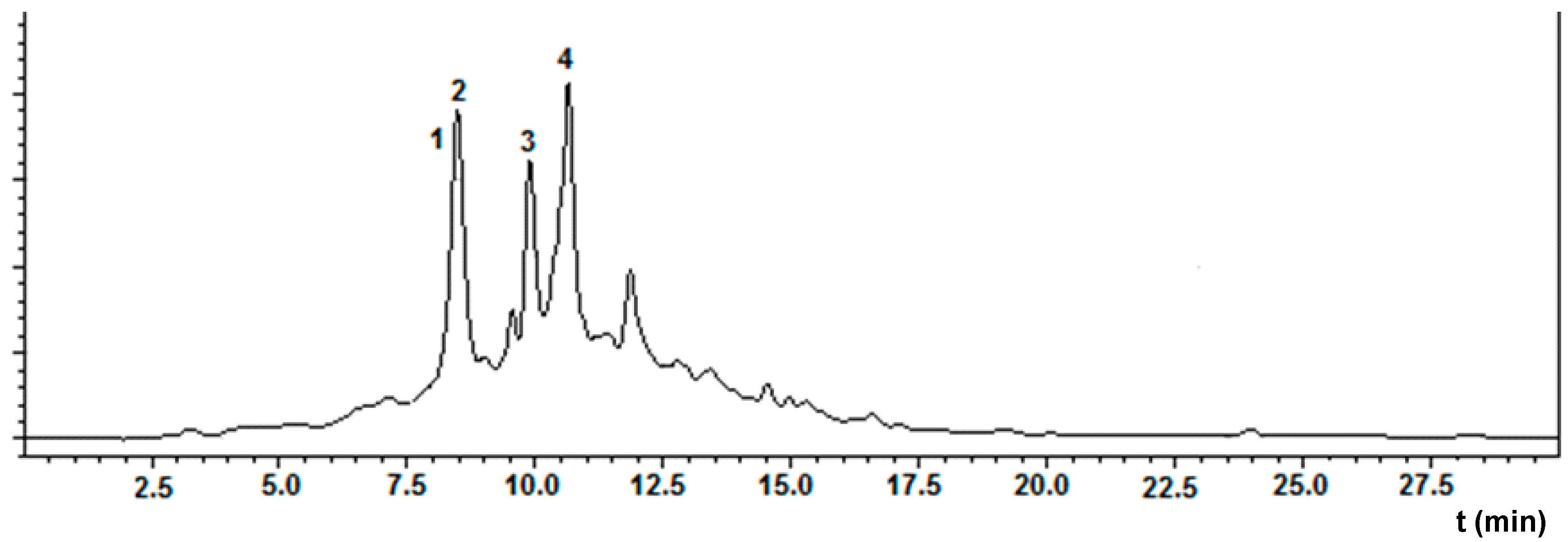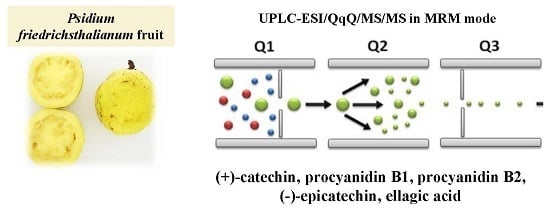Targeted Metabolomic Analysis of Polyphenols with Antioxidant Activity in Sour Guava (Psidium friedrichsthalianum Nied.) Fruit
Abstract
:1. Introduction
2. Results and Discussion
2.1. Fractionation of Sour Guava Extract
2.2. Targeted Analysis of Phenolic Compounds in Ethyl Acetate Fraction
2.3. Fractionation of Ethyl Acetate Fraction
3. Materials and Methods
3.1. Fruits
3.2. Chemicals
3.3. Extraction
3.4. Determination of Total Phenolic Content by Folin-Ciocalteou Method
3.5. Determination of Antioxidant Activity by ABTS Assay
3.6. Targeted Metabolomic Analysis of Phenolic Compounds
3.7. LC-MS Analyses
3.8. Purification of Compound 3
3.9. Statistic Analysis
4. Conclusions
Acknowledgments
Author Contributions
Conflicts of Interest
References
- Sanda, K.A.; Grema, H.A.; Geidman, Y.A.; Bukar-Kolo, Y.M. Pharmacological aspects of Psidium guajava: An update. Int. J. Pharmacol. 2011, 7, 316–324. [Google Scholar] [CrossRef]
- Gutierrez, R.M.; Mitchell, S.; Solis, R.V. Psidium guajava: A review of its traditional uses, phytochemistry and pharmacology. J. Ethnopharmacol. 2008, 117, 1–27. [Google Scholar] [CrossRef] [PubMed]
- Flores, G.; Wu, S.B.; Negrin, A.; Kennelly, E.J. Chemical composition and antioxidant activity of seven cultivars of guava (Psidium guajava) fruits. Food Chem. 2015, 170, 327–335. [Google Scholar] [CrossRef] [PubMed]
- Cuadrado-Silva, C.T.; Pozo-Bayón, M.A.; Osorio, C. Identification of aroma compounds and precursors of sour guava (Psidium friedrichsthalianum Nied.) following a sensomics approach. Eur. Food Res. Technol. 2016. [Google Scholar] [CrossRef]
- Flores, G.; Dastmalchi, K.; Wu, S.-B.; Whalen, K.; Dabo, A.J.; Reynertson, K.A.; Foronjy, R.F.; D’Armiento, J.M.; Kennelly, E.J. Phenolic-rich extract from the Costa Rican guava (Psidium friedrichsthalianum) pulp with antioxidant and anti-inflammatory activity. Potential for COPD therapy. Food Chem. 2013, 141, 889–895. [Google Scholar] [CrossRef] [PubMed]
- Miguel, M.G. Antioxidant activity of medicinal and aromatic plants. A review. Flavour Frag. J. 2010, 25, 291–312. [Google Scholar] [CrossRef]
- Finley, J.W.; Kong, A.N.; Hintze, K.J.; Jeffery, E.H.; Ji, L.L.; Lei, X.G. Antioxidants in foods: state of the science important to the food industry. J. Agric. Food Chem. 2011, 59, 6837–6846. [Google Scholar] [CrossRef] [PubMed]
- Soto-Vaca, A.; Gutierrez, A.; Losso, J.N.; Xu, Z.; Finley, J.W. Evolution of phenolic compounds from colour and flavor problems to health benefits. J. Agric. Food Chem. 2012, 60, 6658–6677. [Google Scholar] [CrossRef] [PubMed]
- Gómez-Romero, M.; Segura-Carretero, A.; Fernández-Gutiérrez, A. Metabolite profiling and quantification of phenolic compounds in metanol extracts of tomato fruit. Phytochemisty 2010, 71, 1848–1864. [Google Scholar] [CrossRef] [PubMed]
- Lambert, M.; Meudec, E.; Verbaere, A.; Mazerolles, G.; Wirth, J.; Masson, G.; Cheyner, V.; Sommerer, N. A high-throughput UHPLC-QqQ-MS method for polyphenol profiling in Rosé wines. Molecules 2015, 20, 7890–7914. [Google Scholar] [CrossRef] [PubMed]
- Simirgiotis, M.J.; Quispe, C.; Bórquez, J.; Areche, C.; Sepúlveda, B. Fast detection of phenolic compounds in extracts of easter pears (Pyrus communis) from the Atacama desert by Ultrahigh-Performance Liquid Chromatography and Mass Spectrometry (UHPLC-Q/Orbitrap/MS/MS). Molecules 2016, 21, 92. [Google Scholar] [CrossRef] [PubMed]
- Vrhovsek, U.; Masuero, D.; Gasperotti, M.; Franceschi, P.; Caputi, L.; Viola, R.; Mattivi, F. A versatile targeted metabolomics method for the rapid quantification of multiple classes of phenolics in fruits and beverages. J. Agric. Food Chem. 2012, 60, 8831–8840. [Google Scholar] [CrossRef] [PubMed]
- Isaza, J.H.; Ito, H.; Yoshida, T. Oligomeric hidrolizable tannins from Monochaetum multiflorum. Phytochemistry 2004, 65, 359–367. [Google Scholar] [CrossRef] [PubMed]
- Li, H.J.; Deinzer, M.L. Tandem mass spectrometry for sequencing proanthocyanidins. Anal. Chem. 2007, 79, 1739–1748. [Google Scholar] [CrossRef] [PubMed]
- Gall, E. Análisis de Metabolitos tras la Ingestión de Alimentos Ricos en Polifenoles. Proyecto fin de Grado en Química, Curso 2014/2015. Instituto de Investigación en Ciencias de la Alimentación, Universidad Autónoma de Madrid: Madrid, Spain, 2015. [Google Scholar]
- Sánchez-Patán, F.; Monagas, M.; Moreno-Arribas, M.V.; Bartolomé, B. Determination of microbial phenolic acids in human faeces by UPLC-ESI-TQ MS. J. Agric. Food Chem. 2011, 5, 2241–2247. [Google Scholar] [CrossRef] [PubMed]
- Sánchez-Patán, F.; Cueva, C.; Monagas, M.; Walton, G.E.; Gibson, G.R.; Martín-Álvarez, P.J.; Moreno-Arribas, M.V.; Bartolomé, B. Gut microbial catabolism of grape seed flavan-3-ols by human faecal microbiota. Targeted analysis of precursor compounds, intermediate metabolites and end-products. Food Chem. 2012, 131, 337–347. [Google Scholar] [CrossRef] [Green Version]
- Jara-Palacios, M.J.; Hernanz, D.; González-Manzano, S.; Santos-Buelga, C.; Escudero-Gilete, M.L.; Heredia, F.J. Detailed phenolic composition of white grape by-products by RRLC/MS and measurement of the antioxidant activity. Talanta 2014, 125, 51–57. [Google Scholar] [CrossRef] [PubMed]
- Landete, J.M. Ellagitannings, ellagic acid and their derived metabolites: A review about source, metabolism, functions and health. Food Res. Int. 2011, 44, 1150–1160. [Google Scholar] [CrossRef]
- Appeldoorn, M.M.; Sanders, M.; Vincken, J.-P.; Cheynier, V.; le Guernevé, C.; Hollman, P.C.H.; Gruppen, H. Efficient isolation of major procyanidin A-type dimers from peanut skins and B-type dimers from grape seeds. Food Chem. 2009, 117, 713–720. [Google Scholar] [CrossRef]
- AOAC. Official Methods of Analysis of AOAC International, 18th ed.; Association of Official Analytical Chemists: Gaithersburg, MD, USA, 2006. [Google Scholar]
- Singleton, V.L.; Rossi, J.A. Colorimetry of total phenolics with phosphomolybdic-phosphotungstic acid reagents. Am. J. Enol. Vitic. 1965, 16, 144–158. [Google Scholar]
- Re, R.; Pellegrini, N.; Proteggente, A.; Pannala, A.; Yang, M.; Rice-Evans, C. Antioxidant activity applying an improved ABTS radical cation decolorization assay. Free Radic. Biol. Med. 1999, 26, 1231–1237. [Google Scholar] [CrossRef]
- International Organization for Standardization ISO 3534-1: 2006. Part 1: Probability and general statistical terms. In Statistics Vocabulary and Symbols; ISO: Geneva, Switzerland, 2006. [Google Scholar]
- Contreras-Calderón, J.; Calderón-Jaimes, L.; Guerra-Hernández, E.; García-Villanova, B. Antioxidant capacity, phenolic content and vitamin C in pulp, peel and seed from 24 exotic fruits from Colombia. Food Res. Int. 2011, 44, 2047–2053. [Google Scholar] [CrossRef]
- Medina, M.B. Determination of the total phenolics in juices and superfruits by a novel chemical method. J. Funct. Foods 2011, 3, 79–87. [Google Scholar] [CrossRef]
- Sample Availability: Not available.


| Fraction | Amount Isolated (g) | Concentration of Total Phenolics (mg GAE/100 g Fruit ± SD) * | Antioxidant Activity (mM Trolox Equivalent/kg Fruit ± SD) * |
|---|---|---|---|
| F.Ether | 6.9 | 25.94 ± 0.05 a | 0.16 ± 0.09 a |
| F.EtOAc | 5.9 | 138.08 ± 0.07 b | 0.85 ± 0.05 b |
| F.BuOH | 29.1 | 71.95 ± 0.05 c | 0.14 ± 0.01 a |
| F.aqueous | 200.8 | 92.32 ± 0.02 d | 0.02 ± 0.00 c |
| F.EtOAc.1 | 3.4 | - | 2.08 ± 0.11 d |
| F.EtOAc.2 | 1.0 | - | 10.99 ± 1.09 e |
| F.EtOAc.3 | 0.8 | - | 0.66 ± 0.01 f |
| F.EtOAc.4 | 0.6 | - | 0.40 ± 0.21 g |
| F.EtOAc.2.1 | 0.186 | - | 3.19 ± 0.13 h |
| F.EtOAc.2.2 | 0.199 | - | 0.22 ± 0.01 i |
| F.EtOAc.2.3 | 0.406 | - | 4.76 ± 0.22 j |
| F.EtOAc.2.4 | 0.226 | - | 3.09 ± 0.15 h |
| F.EtOAc.2.5 | 0.044 | - | 3.14 ± 0.04 h |
| F.EtOAc.2.6 | 0.020 | - | 2.76 ± 0.35 h |
| F.EtOAc.2.7 | 0.003 | - | 2.84 ± 0.46 h |
| Compound | Amount (mg/g Fraction) | Retention Time (min) | Molecular Mass (u) | MRM Transition | Calibration Range (μg/mL) * | LOD (μg/mL) * | LOQ (μg/mL) * |
|---|---|---|---|---|---|---|---|
| Benzoic acids and derivatives (C6–C1) | |||||||
| Benzoic acid | 0.276 ± 0.029 | 8.49 | 122.12 | 121 > 77 | 12.50–0.39 | 0.090 | 0.200 |
| 4-Hydroxybenzoic acid | 0.002 ± 0.000 | 4.43 | 138.12 | 137 > 93 | 3.13–0.06 | 0.012 | 0.025 |
| Protocatechuic acid | 0.081 ± 0.006 | 3.34 | 154.12 | 153 > 109 | 3.13–0.02 | 0.006 | 0.012 |
| Vanillic acid | 0.204 ± 0.005 | 5.43 | 166.14 | 165 > 121 | 25.12–0.39 | 0.050 | 0.098 |
| Phthalic acid | 0.023 ± 0.002 | 5.34 | 166.14 | 165 > 121 | 3.13–0.02 | 0.012 | 0.025 |
| Gallic acid | 0.693 ± 0.010 | 1.73 | 170.12 | 169 > 125 | 1.56–0.05 | 0.012 | 0.025 |
| 3-O-Methylgallic acid | 0.007 ± 0.001 | 4.22 | 184.15 | 183 > 168 | 1.56–0.01 | 0.007 | 0.016 |
| Syringic acid | 0.040 ± 0.010 | 5.95 | 198.17 | 197 > 182 | 1.56–0.10 | 0.012 | 0.030 |
| Phenylacetic acids (C6–C2) | |||||||
| Phenylacetic acid | 1.087 ± 0.088 | 8.77 | 136.15 | 135 > 91 | 12.50–0.78 | 0.390 | 0.780 |
| 3,4-Dihydroxyphenylacetic acid | 0.001 ± 0.000 | 4.16 | 168.15 | 167 > 123 | 0.39–0.01 | 0.003 | 0.007 |
| 4-Hydroxymandelic acid | 0.092 ± 0.001 | 1.42 | 168.15 | 167 > 123 | 6.25–0.20 | 0.098 | 0.196 |
| Phenylpropanoic acids and derivatives (C6–C3) | |||||||
| Caffeic acid | 0.020 ± 0.005 | 5.46 | 180.16 | 179 > 135 | 3.13–0.05 | 0.024 | 0.049 |
| Isoferulic acid | 0.020 ± 0.007 | 8.40 | 194.18 | 193 > 134 | 0.78–0.05 | 0.024 | 0.049 |
| Ferulic acid | 0.021 ± 0.002 | 7.81 | 194.18 | 193 > 134 | 3.13–0.02 | 0.006 | 0.012 |
| Flavan-3-ols (C6–C3–C6) | |||||||
| (+)-Catechin | 17.952 ± 1.404 | 5.22 | 290.26 | 289 > 245 | 6.25–0.05 | 0.012 | 0.024 |
| (−)-Epicatechin | 9.525 ± 1.581 | 6.36 | 290.27 | 289 > 245 | 3.13–0.05 | 0.018 | 0.049 |
| Procyanidin A2 | 0.049 ± 0.002 | 9.02 | 576.51 | 575 > 449 | 3.13–0.05 | 0.006 | 0.024 |
| Procyanidin B1 | 14.149 ± 1.454 | 4.91 | 578.52 | 577 > 289 | 25.00–0.20 | 0.050 | 0.1000 |
| Procyanidin B2 | 10.820 ± 1.122 | 5.94 | 578.52 | 577 > 289 | 25.00–0.39 | 0.030 | 0.060 |
| Others (Phenols, lactones) | |||||||
| α-Valerolactone | 0.024 ± 0.014 | 3.45 | 100.12 | 101 > 55 | 1.56–0.05 | 0.024 | 0.098 |
| Pyrogallol | 0.059 ± 0.008 | 1.69 | 126.11 | 125 > 79 | 1.56–0.05 | 0.024 | 0.049 |
| Ellagic acid | 4.755 ± 0.105 | 14.61 | 302.20 | 301 > 145 | 50.00–1.56 | 0.268 | 0.521 |
© 2016 by the authors. Licensee MDPI, Basel, Switzerland. This article is an open access article distributed under the terms and conditions of the Creative Commons Attribution (CC-BY) license ( http://creativecommons.org/licenses/by/4.0/).
Share and Cite
Cuadrado-Silva, C.T.; Pozo-Bayón, M.Á.; Osorio, C. Targeted Metabolomic Analysis of Polyphenols with Antioxidant Activity in Sour Guava (Psidium friedrichsthalianum Nied.) Fruit. Molecules 2017, 22, 11. https://doi.org/10.3390/molecules22010011
Cuadrado-Silva CT, Pozo-Bayón MÁ, Osorio C. Targeted Metabolomic Analysis of Polyphenols with Antioxidant Activity in Sour Guava (Psidium friedrichsthalianum Nied.) Fruit. Molecules. 2017; 22(1):11. https://doi.org/10.3390/molecules22010011
Chicago/Turabian StyleCuadrado-Silva, Carmen Tatiana, Maria Ángeles Pozo-Bayón, and Coralia Osorio. 2017. "Targeted Metabolomic Analysis of Polyphenols with Antioxidant Activity in Sour Guava (Psidium friedrichsthalianum Nied.) Fruit" Molecules 22, no. 1: 11. https://doi.org/10.3390/molecules22010011







